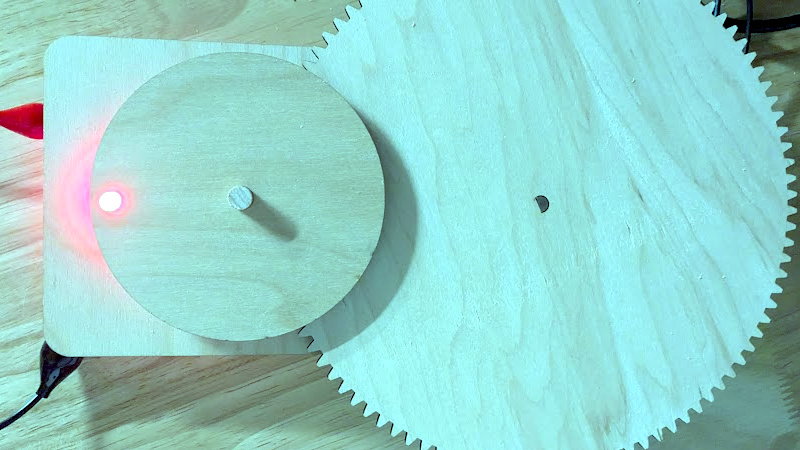Making an LED blink is usually achieved by interrupting its power supply, This can be achieved through any number of oscillator circuits, or even by means of a mechanical system and a switch. For the 2025 One Hertz Challenge though, [jeremy.geppert] has eschewed such means. Instead his LED is always on, and is made to flash by interrupting its light beam with a gap once a second.
This mechanical solution is achieved via a disk with a hole in it, rotating once a second. This is driven from a gear mounted on a 4.8 RPM geared synchronous motor, and the hack lies in getting those gears right. They’re laser cut from ply, from an SVG generated using an online gear designer. The large gear sits on the motor and the small gear on the back of the disk, which is mounted on a bearing. When powered up it spins at 60 RPM, and the LED flashes thus once a second.
We like this entry for its lateral thinking simplicity. The awesome 2025 One Hertz Challenge is still ongoing, so there is still plenty of time for you to join the fun!
















And the obvious next step is to provide additional gears in the correct ratios to blink once per minute, hour, day, and year.
Or switch phase to implement a morse code blinker capable of emergency maritime signalling.
For extra-hackaday-ness, rig it up a light-sensor on a networked device that triggers “wget https://hackaday.com” with each pulse.
Seems like Hackaday ITSELF could join the One Hertz Challenge, simply by renaming the site to Hackasecond.
Only laterally related, but old-school record player platter rotating at 33 1/3 RPMs synched to the mains, provide half the speed needed.
True story – a relative of mine “invented” a mains-powered incandescent blinker back in the late 1960s. He was given an old/decrepit record player that wasn’t spinning (turns out there was a wire that came loose inside – soldering the thing made it work). e already owned one of those “music consoles” with radio and record player unit inside, so he went on to make use of the extra player. He cut “record” from spare piece of plywood and covered half of it with a tin foil that was pressed against the spindle, which made it grounded (the record players’ platter assembly is usually made from metal that’s suspended on damper springs; entire thing is connected to the ground, so the spindle IS the ground). He then attached a thick wire to the tonearm up to “pick” the on-off ground, and connected that wire to a spare incandescent bulb. Turning the player on and putting tonearm on the “record” completed the trick; depending where the pickup was pointed at would make the bulb blink at different frequencies. Obviously, safety wasn’t the greatest concern, and sparks were seen every time the circuit would complete/break, but it was a working demonstration nonetheless. :- ]
The grid is not synchronized to the currently available definition of second. Its frequency varies with load, power generated by renewables, electric cars etc.
Cool. One obvious improvement is to fix the light leakage. Direct light from the LED is reflected back to the board and then reflected again through the hole.
Painting the boards in front and behind the LED matte black would help a lot.
I think I’ll have to resign on never ever getting used to the ‘an’ LED thing, you can tell me it’s correct and sure it is, but it does not look or feel correct and I gave up expecting that I’ll get used to it.
So if I ever say ‘a LED’ in a comment then don’t try to correct me, TIA.
It depends on how you pronounce “LED.”
If you pronounce it like “lead” then it is “a LED.”
If you pronounce it spelled out as “L-E-D” then it is “an L-E-D” because the letter “L” pronounced by itself starts with a vowel sound (“el”.) “A” is an article, as is “an.” If the word after the article starts with a consonant, then you use “A.” If the word after the article starts with a vowl sound (“AEIOU”) then you use “An.”
The word after the article here is “Posted”